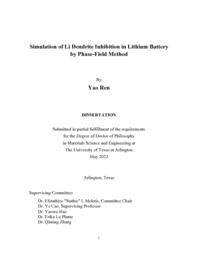
ATTENTION: The works hosted here are being migrated to a new repository that will consolidate resources, improve discoverability, and better show UTA's research impact on the global community. We will update authors as the migration progresses. Please see MavMatrix for more information.
Show simple item record
| dc.contributor.advisor | Meletis, Efstathios I. | |
| dc.creator | Ren, Yao | |
| dc.date.accessioned | 2023-06-28T15:37:44Z | |
| dc.date.available | 2023-06-28T15:37:44Z | |
| dc.date.created | 2022-05 | |
| dc.date.issued | 2022-05-16 | |
| dc.date.submitted | May 2022 | |
| dc.identifier.uri | http://hdl.handle.net/10106/31391 | |
| dc.description.abstract | Lithium (Li) dendrite growth poses serious challenges for the development of Li metal batteries which also stops the footsteps of human utilizing the environment-friendly new power source. Replacing liquid electrolyte with solid electrolyte can not only inhibit the dendrite growth by mechanical suppression, but also introduce more possibilities to the electrochemistry of battery. However, the underlying mechanism is still not fully understood, and most theoretical works focus on pure liquid electrolyte, ignoring the mechanical strain effects. Here we developed a phase-field model which simulates the Li dendrite growth to study the competition between diffusion and deposition rates, the pure elastic and Elasto-plastic effects, and the inhibition from nanofillers embedded in the solid electrolytes. It is revealed that high diffusion rate can transport more Li ions to the electrode surface, which create a low concentration gradient at the interface, leading to a smooth electrode surface.
Li dendrite can also be effectively inhibited by the electrolytes of high elastic modulus and initial yield strength, which induce and withstand the large mechanical suppression, respectively. High-throughput phase-field simulations are performed to establish a database of relationships between the aforementioned mechanical properties and the Li dendrite morphology, based on which a compressed-sensing machine learning model is trained to derive interpretable analytical correlations between the key material parameters and the dendrite morphology, as described by the dendrite length and area ratio. It is revealed that the Li dendrite can be effectively inhibited by the electrolytes of high elastic modulus and initial yield strength. Meanwhile, the role of the yield strength of Li metal is also critical when the yield strength of the electrolyte becomes low.
We also discovered that the introduction of the 1D nanofiber arrays could confine the Li ion transport along horizontal direction, reduce the concentration gradient across the electrode/electrolyte interface, and inhibit the Li dendrite growth. Our work provides deep understanding of the dendrite growth mechanism, the mechanical suppression and the inhibition by the 1D nanofiber array, as well as the designing strategy for the solid composite electrolyte for improved Li anode stability and Li ion conductivity.
Furthermore, we also explored the formation process of dead Li and study the formation mechanism. It is found that the initial Li amount affects the dead Li most while the high discharge voltage will also lead to the formation of dead Li. | |
| dc.format.mimetype | application/pdf | |
| dc.language.iso | en_US | |
| dc.subject | Lithium dendrite | |
| dc.subject | Mechanical suppression | |
| dc.subject | Polymer composite electrolyte | |
| dc.subject | Elasto-plastic effects | |
| dc.subject | Machine learning | |
| dc.subject | Dead lithium | |
| dc.subject | Phase-field simulation | |
| dc.title | Simulation of Li Dendrite Inhibition in Lithium Battery by Phase-Field Method | |
| dc.type | Thesis | |
| dc.date.updated | 2023-06-28T15:37:44Z | |
| thesis.degree.department | Materials Science and Engineering | |
| thesis.degree.grantor | The University of Texas at Arlington | |
| thesis.degree.level | Doctoral | |
| thesis.degree.name | Doctor of Philosophy in Materials Science and Engineering | |
| dc.type.material | text | |
| dc.creator.orcid | 0000-0003-2049-6122 | |
Files in this item
- Name:
- REN-DISSERTATION-2022.pdf
- Size:
- 6.201Mb
- Format:
- PDF
- Name:
- THESIS-YAO REN.docx
- Size:
- 10.30Mb
- Format:
- Microsoft Word 2007
This item appears in the following Collection(s)
Show simple item record


